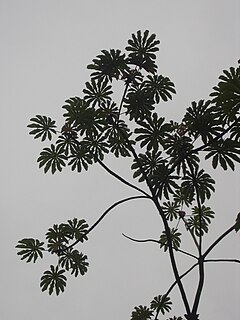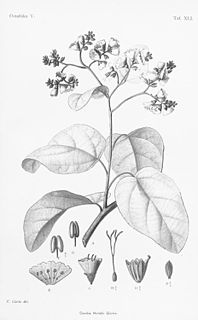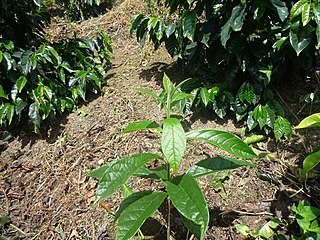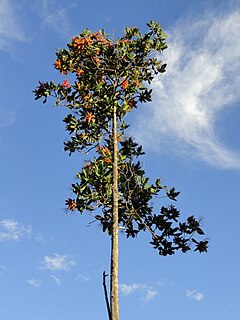 W
WMyrmecophytes are plants that live in a mutualistic association with a colony of ants. There are over 100 different genera of myrmecophytes. These plants possess structural adaptations that provide ants with food and/or shelter. These specialized structures include domatia, food bodies, and extrafloral nectaries. In exchange for food and shelter, ants aid the myrmecophyte in pollination, seed dispersal, gathering of essential nutrients, and/or defense. Specifically, domatia adapted to ants may be called myrmecodomatia.
 W
WA domatium is a tiny chamber produced by plants that houses arthropods.
 W
WCecropia obtusifolia is a species of plant in the family Urticaceae. It is found in Colombia, Costa Rica, Nicaragua, Mexico and Panama. Common Names include trumpet tree, pop-a-gun, tree-of-laziness, and snakewood tree. In Central America it is known as Guarumo. Though impressive silhouetted against the sky, it is an invasive species in the islands of Hawaii.
 W
WCordia africana is a species of flowering tree in the borage family, Boraginaceae, that is native to Africa.
 W
WCordia alliodora is a species of flowering tree in the borage family, Boraginaceae, that is native to the American tropics. It is commonly known as Spanish elm, Ecuador laurel, cypre or salmwood. It can reach 35 m in height.
 W
WDischidia major, the Malayan urn vine, is an unusual plant. Dischidia is a genus of some 80 species of trailing, twining or scandent, succulent epiphytes found throughout the tropics of Asia through to the western Pacific. They carry modified leaves, offering accommodation to ants, including those of the family Dolichoderinae, and in return gain some sustenance from increased carbon dioxide and nitrogen levels, and a degree of protection from noxious animals and plants. This mutualism trait, known as myrmecophily, is widespread across the plant world and clearly carries considerable benefits for both ants and plant.
 W
WHydnophytum is a genus of epiphytic myrmecophytes native to Southeast Asia, the Pacific region and also extending into Queensland in northern Australia. The name is derived from the Ancient Greek hydnon "tuber", and phyton "plant", after their appearance with their swollen succulent stems. The species grow in tree branches and on trunks. Like the related genus Myrmecodia, they are known as antplants or ant-house plants. The type species is Hydnophytum formicarum from the Philippines. The genus contains 55 species, of which 44 are found in and around the island of New Guinea. Many are poorly known, with 11 known only from the holotype.
 W
WHydnophytum formicarum is a species in the genus Hydnophytum, thus making it an epiphyte and a myrmecophyte. It is native to Southeast Asia and is considered critically endangered in Singapore.
 W
WLecanopteris is a genus of ferns in the family Polypodiaceae, subfamily Microsoroideae, according to the Pteridophyte Phylogeny Group classification of 2016 (PPG I). They have swollen hollow rhizomes that provide homes for symbiotic ants. All are epiphytic plants that naturally occur from Southeast Asia to New Guinea. Several species are in commerce, being grown as houseplants and greenhouse curiosities.
 W
WLeporella fimbriata, commonly known as hare orchid or fringed hare orchid, is the only species in the flowering plant genus Leporella in the orchid family, Orchidaceae and is endemic to the southern Australia mainland. It is related to orchids in the genus Caladenia but has an unusual labellum and does not have hairy leaves. Its pollination mechanism is also unusual.
 W
WMonolena is a genus of flowering plants in the family Melastomataceae, consisting of about 15 species distributed from Guatemala to Peru and Acre in Brazil. They are primarily herbs of the wet tropical forest and cloud forest, often growing as epiphytes, but sometimes on rocks within streams.
 W
WMyrmecodia is a genus of epiphytic myrmecophytes, native to Southeast Asia, but also present in Indochina, Malaysia, the Southwest Pacific, the Philippines, Fiji, and extending south to Queensland and Cape York in Australia. It is one of five ant-plant genera in the family Rubiaceae, the others being Anthorrhiza, Hydnophytum, Myrmephytum, and Squamellaria.
 W
WMyrmecodia beccarii, ant-house plant, is an epiphytic plant on Melaleuca trees and others with spongy bark in the wetlands and mangroves of tropical north Queensland, Australia from Cooktown to Mission Beach. The prickly, swollen stems develop natural hollows which are invaded by the golden ant in a symbiotic arrangement. The ants patrol the plant, removing leaf-eaters, while their excreta is absorbed by the plant for nutrition.
 W
WNepenthes bicalcarata, also known as the fanged pitcher-plant, is a tropical pitcher plant endemic to northwestern Borneo, Indonesia. It is a myrmecophyte noted for its mutualistic association with a species of ant, Camponotus schmitzi. As an ant-fed plant it lacks many of the features that characterise the carnivorous syndrome in Nepenthes, including viscoelastic and highly acidic pitcher fluid, the waxy zone of the pitcher interior, and possibly even functional digestive enzymes.
 W
WSquamellaria is a genus of myrmecophytic flowering plants in the family Rubiaceae. It is endemic to the islands of Fiji.
 W
WTriplaris americana is a species of flowering plant in the knotweed family known by many common names, including ant tree or pau-formiga, guacamayo, guayabo zancón, hormiguero, palo de Santa María, tachí, vara santa, pau-de-novato, formigueiro, taxizeiro, and devil tree.' 'It is native to Central and South America, occurring from Panama to Brazil. It is also cultivated as an ornamental for its showy pink flowers.
 W
WVachellia cornigera, commonly known as bullhorn acacia, is a swollen-thorn tree native to Mexico and Central America. The common name of "bullhorn" refers to the enlarged, hollowed-out, swollen thorns that occur in pairs at the base of leaves, and resemble the horns of a steer. In Yucatán it is called "subín", in Panamá the locals call them "cachito". The trees are commonly found in wet lowlands
 W
WVachellia drepanolobium, commonly known as whistling thorn, is a swollen-thorn acacia native to East Africa. The whistling thorn grows up to 6 meters tall. It produces a pair of straight spines at each node, some of which have large bulbous bases. These swollen spines are naturally hollow and occupied by any one of several symbiotic ant species. The common name of the plant is derived from the observation that when wind blows over bulbous spines in which ants have made entry/exit holes, they create a whistling noise.